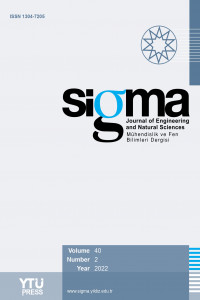The hydrogeological functioning of the karstic aquifer in Sidi Kada Mountains (North-Western Algeria) from hydrochemical records
Abstract
This study focuses on the hydrodynamic and hydrochemical functioning of the karst system in Sidi Kada Mountains. These later extend between the Ghriss plain in the North and the Saida Mountains in the South. The hydrochemical approach was used to understand the hydrodynamic behaviour of the karst system which is represented by dolomitic limestone formation of Upper Jurassic. The geological data were used to delimit an impluvium with an area of 535.1 km2 and a perimeter of 220.7 km. The functioning of this karst system was studied using several physic-chemical parameters, namely pH, temperature, electrical conductivity, TDS, Ca2+, Mg2+, Na+, HCO3–, Cl–, NO3–, SO42–. Frequency distributions of the water electrical conductivity (CFD) indicate that the system is characterized by two hydrodynamic sub-regimes, in which fracture networks control the base flow and conduit networks control the quick flow. The results of the hydrochemical analysis show that the waters facies are bicarbonated and magnesian. During periods of high water, the contents of chemical elements decreased, except for calcium and nitrates. During periods of low water, the participation of the saturated zone generates an increase in Mg2+ contents. The waters are typically characterised by an average conductivity of 848 μS/cm in deep waters. The shallow waters, influenced by anthropogenic actions, have an average conductivity of 1344 μS/cm and waters where exists the evaporite lenticular mass have relatively high values of conductivity, ranging from 1886 to 2644 μS/cm with an average of 2102 μS/cm. The good correlation between the chlorides and sulphates indicates the leaching of the soil layer. The correlation between Ca2+ and SO42− is negative but weak (r = –0.176), implied that Ca2+ was no derived from gypsum in the majority of samples. In contrast the water points whose chemistry is marked by the dissolution of gypsum or anhydrites have a good correlation between Ca2+ and SO42− (r = 0.93). The supersaturating regarding calcite and dolomite indices indicates mainly a flow in the saturated zone and through the unsaturated zone with a relatively high pCO2 (from 1.5 × 10–2 to 4 × 10–2). Biogenic CO2 initiates the mineralisation process in the unsaturated zone within an open system. The relationship between the saturation indices regarding calcite and dolomite shows that 87% of water varied from equilibrium and oversaturated. This is indicative of a slightly aggressive water with relatively slow circulation.
References
- The article references can be accessed from the .pdf file.
Details
| Primary Language | English |
|---|---|
| Subjects | Engineering |
| Journal Section | Research Articles |
| Authors | |
| Publication Date | June 6, 2022 |
| Submission Date | September 9, 2020 |
| Published in Issue | Year 2022 Volume: 40 Issue: 2 |
IMPORTANT NOTE: JOURNAL SUBMISSION LINK https://eds.yildiz.edu.tr/sigma/


